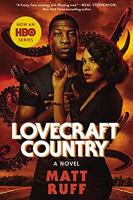
I’m what we librarians call a gentle horror reader. I’m fascinated by the supernatural but can’t handle graphic violence or gore. I normally indulge in juvenile scary stories or classics like Bram Stoker’s Dracula and Mary Shelley’s Frankenstein. I heard a lot of buzz around Matt Ruff’s horror novel, Lovecraft County, after the release of the critically acclaimed HBO drama series adaptation, created by Misha Green. The premise of resilient and intelligent African American characters grappling with racism and the supernatural in the 1950s intrigued me. This was the perfect horror novel to dive into. You get the creep factor without the night terrors. It’s a blend of historical fiction, pulp noir and Lovecraftian horror and fantasy. I may even brave the series!
Lovecraft Country is a collection of interconnected short stories featuring three close-knit African American families living in 1950s Jim Crow America. Each character is the hero in their own adventure story. The short stories allow readers to see the interior lives of the characters and emphasizes the closeness and collective strength of the families, but the abrupt shift to another point-of-view can take you away from someone you’ve connected with. I liked Ruff’s writing style overall. The short stories are easy to read, action-packed, suspenseful, spine-tingling and feature excellent world-building. I think he used the word “OK” too frequently in dialog and some of the stories dragged. They seem loosely related, but in the penultimate eighth story, all the character’s experiences meld together into a final showdown of good vs. evil.
Atticus, a 22-year-old Korean War veteran and avid science fiction reader, returns home to Chicago in 1954 after receiving a cryptic letter from his estranged father, Montrose. Atticus investigates with his Uncle George– publisher of “The Safe Negro Travel Guide”– and finds out Montrose left for Ardham, Massachusetts with a mysterious white man who claimed to have information about his late wife’s family. Atticus, George and his childhood friend, Letitia Dandridge, go on a dangerous road trip to New England and end up in an isolated town and manor belonging to the sinister Samuel Braithwhite and his son, Caleb. The Braithwhite’s ancestors owned Atticus’s maternal ancestors. Atticus discovers his father imprisoned in chains by a secret society known as the Order of the Ancient Dawn. The Order lured Atticus there to participate in a dangerous ritual. Caleb reappears in all the short stories as the manipulative main antagonist who Atticus and his extended family must outwit.
I expected to be terrified by the supernatural elements, but that wasn’t what truly triggered me. As a Black woman, the scenes of racial terror were what made my skin crawl. Unearthly creatures like shoggaths at least kill indiscriminately. The real horror is toxic race relations and white dominance prompted by the illogical excuse of perceived inferior otherness. Author Matt Ruff brilliantly embodies racial inequity, oppression and white privilege in the Order of the Ancient Dawn. The Order wields vast societal and metaphysical power and the Black characters are denied equal access to said powers and must work smarter to fight back.
Ruff did his research into Black life in the 1950s and the safe spaces they created for fellowship and advancement, such as the Prince Hall Freemasons. There’s enough day-to-day details to firmly ground the reader in the time period, but a lack of historical events and figures. George Berry’s “The Safe Negro Travel Guide” is modeled off “The Negro Motorist Green Book,” published 1936 to 1967 during the segregation era in the United States. Complied by Victor Green, a black postman who lived in the Harlem section of New York, The Green Book identified businesses that would accept African American customers. The goal was to make car travel comfortable and safe for African Americans in the period before the passage of the Civil Rights Act of 1964. Jim Crow (racial segregation) laws pervaded the South, but African American travelers faced pervasive segregation, racism and violence (including lynching) throughout the United States. Atticus, George and Letitia encounter a “sundown town,” where the presence of people of color was banned after nightfall.
Ruff is part of a generation of authors inspired by Howard Phillip Lovecraft (1890-1937), an American author of fantastic and macabre short novels and stories and considered one of the 20th-century masters of the Gothic tale of terror. Lovecraft’s legacy is imprinted on every page of Ruff’s novel, including the title. Ruff maybe an avid fan, but he also actively subverts Lovecraft’s problematic racism. Lovecraft was a proud white supremist who used his writings to disparage those he deemed inferior. Montrose maliciously shows Atticus Lovecraft’s charming 1912 poem, “On the Creation of N*****s.” Who hasn’t had that conundrum when your favorite writer is the worst? His racism isn’t an anomaly in fantasy and science fiction. African Americas are often excluded or sidelined in mainstream fantasy/science fiction stories and fandoms. Artists like Ruff, Victor LaValle and Jordan Peele counter that virulent racism with narratives centered around richly developed African American protagonists who refuse to be cowed by white supremacists.
This book may be uncomfortable to read due to the difficult subject matter, but it will generate introspection in our current climate of racial reckoning and accountability. Ruff shows the residual devastation of enslavement on one African American family. The violent sins of America’s past are forever imprinted on the present and future. Hopefully this book will persuade readers to research and discuss how the legacy of slavery and dehumanization has negatively impacted generations of African Americans and our society. As a white male author, Ruff may not necessarily understand how it truly feels to walk in an African American’s shoes, but he does acknowledge that non-white people experience the United States differently.
